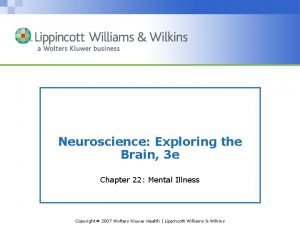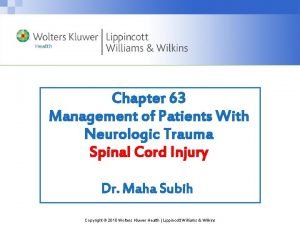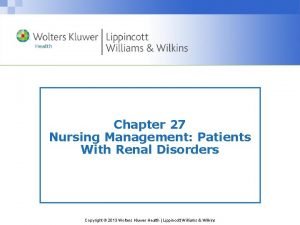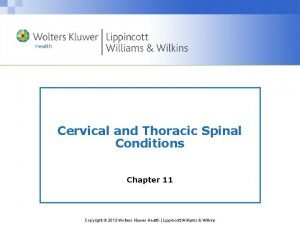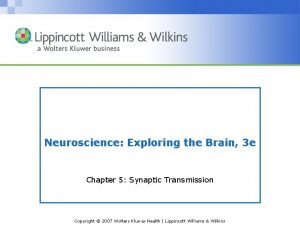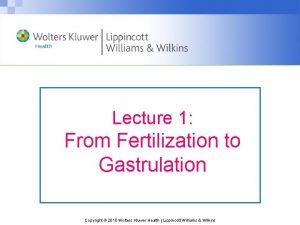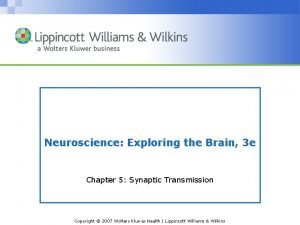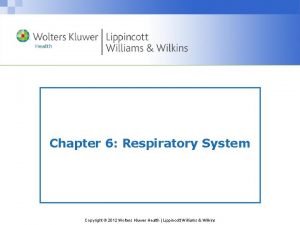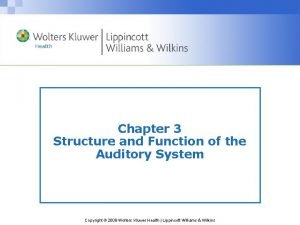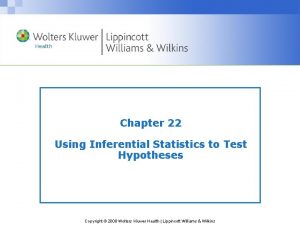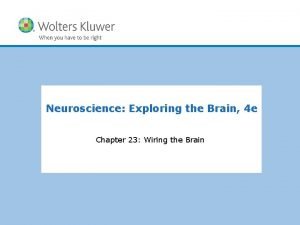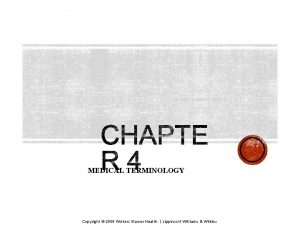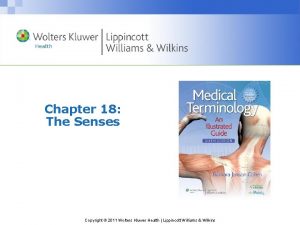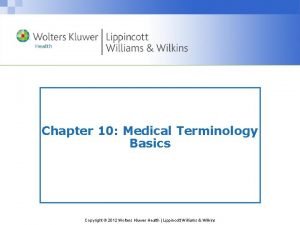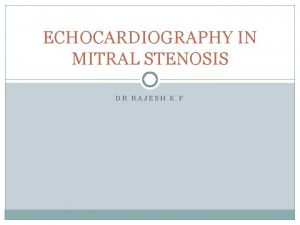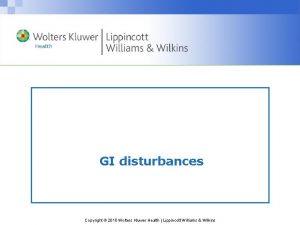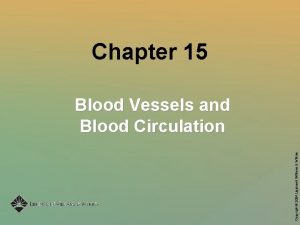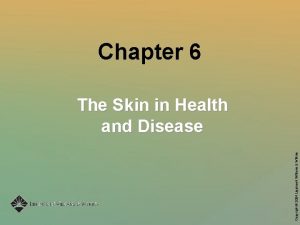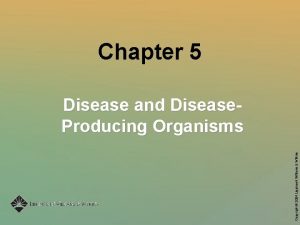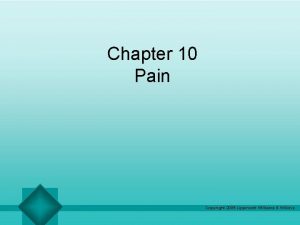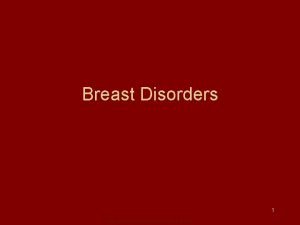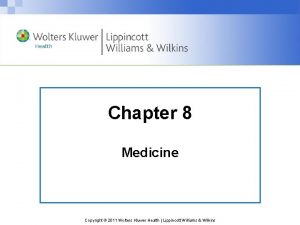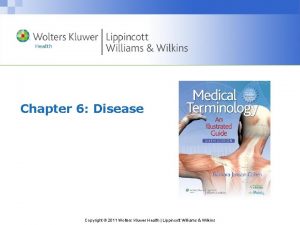Copyright 2011 Wolters Kluwer Health Lippincott Williams Wilkins








































- Slides: 40

Copyright © 2011 Wolters Kluwer Health | Lippincott Williams & Wilkins

Chapter 10 Mood Disorders Copyright © 2011 Wolters Kluwer Health | Lippincott Williams & Wilkins

Mood Disorder Defined • A condition in which a person experiences a prolonged alteration in mood Copyright © 2011 Wolters Kluwer Health | Lippincott Williams & Wilkins

Relevant Terms • Mood: prolonged emotion that colors a person’s entire psychological thinking • Affect: facial expression displayed in association with mood • Euphoria: excessive feeling of happiness • Mania: frenzied, unstable mood • Hypomania: lesser mild-to-moderate form of mania Copyright © 2011 Wolters Kluwer Health | Lippincott Williams & Wilkins

Mood Disorders • Depressive disorders • Dysthymic disorder – Recurrent state of depression over a period of at least two years • Bipolar disorder—manic depression • Cyclothymic disorder – Milder form of bipolar disorder characterized by mood disturbances, which involve periods of hypomanic symptoms and periods of depression Copyright © 2011 Wolters Kluwer Health | Lippincott Williams & Wilkins

Major Depressive Disorder • Persistent, prolonged mood of sadness extending beyond two weeks duration – No episodes of mania or hypomania (unipolar) – Depressed mood – Decreased neurotransmitter action in brain • Usually responds to antidepressant medication – May have precipitating event – May be seasonal Copyright © 2011 Wolters Kluwer Health | Lippincott Williams & Wilkins

Precipitating Factors • Chronic pain • Loss of job • Lack of support system • Financial difficulties • Conflict with a friend or loved one • Recovery from the impact of a difficult situation Copyright © 2011 Wolters Kluwer Health | Lippincott Williams & Wilkins

Depression Signs and Symptoms • Hopelessness, guilt, and self-blame • Somatic complaints (h/a, body pains, GI disturbances) • Anxiety and melancholy • Decreased sex drive • Anergia/anhedonia – Marked decrease in energy level, dependent on others for basic needs – Lack of pleasure in things an individual previously enjoyed • Apathy • Lack of eye contact • Recurrent thoughts of death or suicide Copyright © 2011 Wolters Kluwer Health | Lippincott Williams & Wilkins Box 10. 1 Page 141

Depression: Incidence and Etiology • At least 25% of population will experience in lifetime • Predisposition runs in families • Women at a greater risk • Average of onset is mid-20 s • 15% in major depression will attempt suicide • Possible functional deficit of serotonin in the brain – Leads to a chemical imbalance Copyright © 2011 Wolters Kluwer Health | Lippincott Williams & Wilkins

Dysthymic Disorder Signs and Symptoms • Chronic depression • Often ineffective at coping with loss • Pessimistic attitude • Negativism • Low self-esteem • Poor concentration, decision making Box 10. 2 Page 142 Copyright © 2011 Wolters Kluwer Health | Lippincott Williams & Wilkins

Dysthymia Incidence and Etiology • Occurs 2 -3 times more frequently in women than in men • More likely to occur in first-degree biologic relatives with depressive disorders • Usually an early onset beginning anytime from childhood through early adulthood • May eventually develop bipolar disorder Copyright © 2011 Wolters Kluwer Health | Lippincott Williams & Wilkins

Bipolar Disorders (Manic Depression) • Brain dysfunction that causes abnormal and erratic shifts in mood, energy, and functional ability • Moods range from high manic episodes to low depressive periods • Severity of symptoms from mild to severe Copyright © 2011 Wolters Kluwer Health | Lippincott Williams & Wilkins

Copyright © 2011 Wolters Kluwer Health | Lippincott Williams & Wilkins

Bipolar I and II • Bipolar I—severe manic episodes • Bipolar II—hypomanic episodes • Rapid cycling— 4+ mood shifts within one year Copyright © 2011 Wolters Kluwer Health | Lippincott Williams & Wilkins

Signs and Symptoms of Hypomania/Mania • Extreme euphoria • Inflated self-esteem or grandiosity • Excessive energy • Extreme irritability, moodiness • Reckless and impulsive behaviors Box 10. 3 Page 143 • Sexual indiscretions • Poor hygiene, bizarre dress • Auditory and visual hallucinations • Grandiosity – unrealistic or exaggerated sense of selfworth, importance, wealth, or ability • Clang Associations – rhyming phrases Copyright © 2011 Wolters Kluwer Health | Lippincott Williams & Wilkins

Mania http: //www. youtube. com/watch? v=p 9 hb. XPVa. Ouk http: //www. youtube. com/watch? v=LLVEQgkbw 9 Y Person has a continued mental flood of overly confident self-expectations that lead to frenzied psychomotor activity. Copyright © 2011 Wolters Kluwer Health | Lippincott Williams & Wilkins

Bipolar Disorder: Incidence and Etiology • Genetic factor – familial pattern of illness • Environmental factors • Possible link with substance abuse, stressful life events • Women at a greater risk • If occur in adolescents – may lead to school failure, behavioral problems, and substance use Copyright © 2011 Wolters Kluwer Health | Lippincott Williams & Wilkins

Cyclothymic Disorder • Milder form of bipolar disorder characterized by mood disturbances, which involve periods of hypomanic symptoms and periods of depression – Not longer than two months – No psychotic symptoms – Functioning is not severely impaired – Short periods of normalcy – Equal occurrence in men and women – Begins in adolescence or early adulthood Copyright © 2011 Wolters Kluwer Health | Lippincott Williams & Wilkins

Cyclothymic Disorder Signs and Symptoms • Recurrent episodes of hypomania or dysthymia • States not as severe as in bipolar disorders • Short periods of normalcy • No psychotic symptoms • Functioning not severely impaired Box 10. 4 Page 144 Copyright © 2011 Wolters Kluwer Health | Lippincott Williams & Wilkins

Suicide • Women attempt more often than men • Men are more successful than women • Need for relief from agonizing emotional pain • Eleventh leading cause of death in the United States • All ages, races, socioeconomic status • Often preventable Copyright © 2011 Wolters Kluwer Health | Lippincott Williams & Wilkins

Risk Factors for Suicide • Depressive and bipolar disorders/other mood disorders • Family history • Stressful life events • Substance abuse • Childhood abuse • Chronic illness • Decreased levels of serotonin have been found in those with depression and other mood disorders and in the brains of those who have died by suicide • Loss of a love object, health • Escape from the realities of life Copyright © 2011 Wolters Kluwer Health | Lippincott Williams & Wilkins

Suicide Warning Signs • Difficulty eating and sleeping • Increased substance abuse • Social withdrawal • Preoccupation with death and dying, talks about suicide • Giving away possessions • Previous suicide attempt • Recent major loss • Unnecessary risk taking • Lack of attention to personal hygiene Box 10. 5 • Talks about suicide Page 144 Copyright © 2011 Wolters Kluwer Health | Lippincott Williams & Wilkins

Levels of Risk • Suicidal ideation – Indicates a desire toward self-harm • Suicidal threat – Statement of intent and behavioral changes • Suicidal gesture – Act of suicide an imminent threat • Suicide attempt – Involves definite risk Copyright © 2011 Wolters Kluwer Health | Lippincott Williams & Wilkins

If You Think Someone Might be Suicidal • Do not leave the person alone • Try to get the person immediate medical help • Call 911 • Eliminate access to firearms or other potential suicide tools • Remove any unsupervised access to prescription or overthe-counter drugs • Listen and find support for the person Copyright © 2011 Wolters Kluwer Health | Lippincott Williams & Wilkins

Treatment of Mood Disorders • Pharmacologic • Psychotherapeutic – Antidepressants and Mood-Stabilizing Agents • Psychosocial – Interpersonal and Cognitive Behavior Therapy • Electroconvulsive therapy Copyright © 2011 Wolters Kluwer Health | Lippincott Williams & Wilkins

ECT • Electrical current through the brain • Chanes the neurotransmitter system that leads to the expected mood elevation • Unilateral ECT can lead to short-term memory deficits • Bilateral ECT can lead to long-term memory deficits Copyright © 2011 Wolters Kluwer Health | Lippincott Williams & Wilkins

Nursing Process Applied • Assessment – Mood and affect – Thinking and perceptual ability – Somatic complaints – Sleep disturbances – Changes in energy level – Character of speech patterns Copyright © 2011 Wolters Kluwer Health | Lippincott Williams & Wilkins

Nursing Process Applied (Cont. ) • Nursing diagnoses – Page 146 • Expected outcomes – Page 147 Copyright © 2011 Wolters Kluwer Health | Lippincott Williams & Wilkins

Nursing Process Applied (Cont. ) • Interventions – Individual for each client – Implemented according to the priority of need – Page 147 Copyright © 2011 Wolters Kluwer Health | Lippincott Williams & Wilkins

Interventions for a Suicidal Client • Assess the client for risk factors • Determine the content of suicidal thoughts or ideations • Assess the lethality of method if the client has a plan • Suicide precautions • Active listening • Sense of caring Copyright © 2011 Wolters Kluwer Health | Lippincott Williams & Wilkins

Nursing Process Applied (Cont. ) • Evaluation – Improvement in thought processes, behavior, overall functioning Copyright © 2011 Wolters Kluwer Health | Lippincott Williams & Wilkins

Question • Tell whether the following statement is true or false. Individuals with bipolar disorder experience symptoms of both mania and depression. Copyright © 2011 Wolters Kluwer Health | Lippincott Williams & Wilkins

Answer • True • Rationale: Those with bipolar disorder have moods that range from high manic episodes to low depressive periods. Copyright © 2011 Wolters Kluwer Health | Lippincott Williams & Wilkins

Question • A marked decrease in energy level is also called A. Anergia B. Anhedonia C. Dysthymic disorder D. Negativism Copyright © 2011 Wolters Kluwer Health | Lippincott Williams & Wilkins

Answer • A. Anergia • Rationale: Anergia is a noticeable decrease in energy level, which may make a person depend on others for basic needs. Copyright © 2011 Wolters Kluwer Health | Lippincott Williams & Wilkins

Question • Tell whether the following statement is true or false. Psychotic symptoms are a sign of cyclothymia. Copyright © 2011 Wolters Kluwer Health | Lippincott Williams & Wilkins

Answer • False • Rationale: A person with cyclothymia does not have psychotic symptoms. Copyright © 2011 Wolters Kluwer Health | Lippincott Williams & Wilkins

Question • Which phrase is used to label the first level of suicide risk? A. Suicide attempt B. Suicidal threat C. Suicidal ideation D. Suicidal gesture Copyright © 2011 Wolters Kluwer Health | Lippincott Williams & Wilkins

Answer • C. Suicidal ideation • Rationale: Suicidal ideation is the first level of risk for suicide; it is a verbalized thought or idea that indicates a desire to do self-harm. Copyright © 2011 Wolters Kluwer Health | Lippincott Williams & Wilkins

Case Application • 10. 1 “Sad and Lonely” • 10. 2 “Out of Control” • 10. 3 “Life on the Edge” Copyright © 2011 Wolters Kluwer Health | Lippincott Williams & Wilkins
 Wolters kluwer health lippincott williams & wilkins
Wolters kluwer health lippincott williams & wilkins Wolters kluwer
Wolters kluwer Lippincott williams & wilkins
Lippincott williams & wilkins 2008
2008 Lippincott williams & wilkins
Lippincott williams & wilkins Lippincott williams & wilkins
Lippincott williams & wilkins Lippincott williams & wilkins
Lippincott williams & wilkins Wolters kluwer
Wolters kluwer Lippincott williams & wilkins
Lippincott williams & wilkins Wolters kluwer health
Wolters kluwer health Wolters kluwer health
Wolters kluwer health Chemical synapse
Chemical synapse Wolters kluwer
Wolters kluwer Wolters kluwer health
Wolters kluwer health Wolters kluwer health
Wolters kluwer health Wolters kluwer health
Wolters kluwer health Wolters kluwer
Wolters kluwer Wolters kluwer
Wolters kluwer Exercise physiology for health, fitness, and performance
Exercise physiology for health, fitness, and performance Wolters kluwer
Wolters kluwer Wolters kluwer
Wolters kluwer Virchows triad
Virchows triad Wolters kluwer pronunciation
Wolters kluwer pronunciation Wolters kluwer
Wolters kluwer Chapter 48 skin integrity and wound care
Chapter 48 skin integrity and wound care Wolters kluwer
Wolters kluwer Wolters kluwer
Wolters kluwer Wolters kluwer
Wolters kluwer Wolters kluwer ovid
Wolters kluwer ovid Wolters kluwer culture
Wolters kluwer culture Wolters kluwer pronunciation
Wolters kluwer pronunciation Lippincott williams
Lippincott williams Verna and sam case study
Verna and sam case study Andy williams robert williams
Andy williams robert williams Robbie williams janet williams
Robbie williams janet williams Kluwer
Kluwer Kluwer congres
Kluwer congres Th rogers dress code
Th rogers dress code Wilkins score
Wilkins score Michelle wilkins dr phil
Michelle wilkins dr phil Wilkins score
Wilkins score

